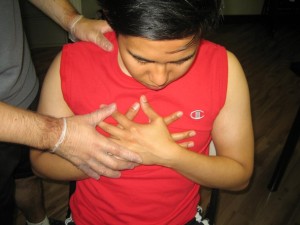Hyperventilation is characterized by rapid breathing. Generally, normal breathing has a balance between inhaling oxygen and exhaling carbon dioxide. This balance is disrupted if hyperventilation arises by exhaling more than inhaling. This results to a rapid drop in carbon dioxide in the body.
Diminished levels of carbon dioxide lead to the constriction of the blood vessels that supply blood to the brain. This drop in the blood supply to the brain triggers symptoms such as lightheadedness and tingling sensation in the fingers.
What are the common causes?
Various factors can lead to hyperventilation. The condition typically results from panic, anxiety, stress or nervousness. If often takes on the form of a panic attack.
Other possible causes include:
- Using stimulants
Hyperventilation might be a serious issue where the symptoms might last for 20-30 minutes. - Bleeding
- Pregnancy
- Drug overdose
- Severe pain
- Lung infection
- Head injuries
- Lung diseases such as asthma or COPD
- Heart conditions such as heart attack
- Diabetic ketoacidosis
- Travelling to areas with elevations over 6,000 feet
- Hyperventilation syndrome
When to seek treatment?
Hyperventilation might be a serious issue where the symptoms might last for 20-30 minutes. It is recommended to seek treatment if the following symptoms arise:
- Fever
- Rapid, deep breathing for the first time
- Pain
- Hyperventilation that gets worse even after using home measures
- Bleeding
- Frequent yawning or sighing
- Feeling anxious, tense or nervous
- Pounding and racing heartbeat
- Chest pain, tightness, pressure or tenderness
- Numbness or tingling in the feet, hands or around the mouth
- Issues with balance, lightheadedness or vertigo
Management
In acute cases of hyperventilation, it is vital to remain calm. The objective of treatment during an episode is to increase the levels of carbon dioxide in the body and slow down the breathing rate.
Home care
Some of these techniques can help manage an acute case such as:
- Breathing via pursed lips
- Breathing slowly into a paper bag or cupped hands
- Try to breathe into the belly (diaphragm) instead of the chest
- Hold your breath for 10-15 seconds at a time
Other measures to manage hyperventilation include:
- Stress reduction – if the individual suffers from stress or anxiety, stress reduction and breathing techniques can help control the condition.
- Acupuncture – this involves placing thin needles into the parts of the body to promote healing
- Medications – depending on the severity, the doctor might prescribe medications such as doxepin, alprazolam and paroxetine.
Quick Note / Disclaimer
The material posted on this page on hyperventilation is for learning and educational purposes only. To learn to recognize and manage respiratory issues, register for a first aid and CPR course with Mississauga First Aid.

